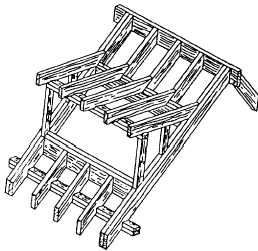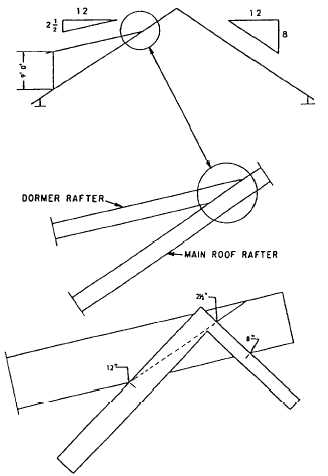Figure 2-58.-Method of framing a shed dormer.
difference between the unit of rise of the dormer roof
and the unit of rise of the main roof. Take the dormer
shown in figure 2-59, for example. The height of the
dormer end wall is 9 feet, or 108 inches. The unit of rise
of the main roof is 8; the unit of rise of the dormer roof
is 2 1/2; the difference is 5 1/2. The total run of a dormer
rafter is therefore 108 divided by 5 1/2, or 19.63 feet.
Knowing the total run and the unit of rise, you can figure
the length of a dormer rafter by any of the methods
already described.
As indicated in figure 2-59, the inboard ends of the
dormer rafters must be cut to fit the slope of the main
roof. To get the angle of this cut, set the square on the
rafter to the cut of the main roof, as shown in the bottom
view of figure 2-59. Measure off the unit of rise of the
dormer roof from the heel of the square along the tongue
as indicated and make a mark at this point. Draw the
cutoff line through this mark from the 12-inch mark.
You figure the lengths of the sidewall studs on a
shed dormer as follows: In the roof shown in figure 2-59,
a dormer rafter raises 2 1/2 units for every 12 units of
run. A main-roof common rafter rises 8 units for every
12 units of run. If the studs were spaced 12 inches OC,
the length of the shortest stud (which is also the common
difference of studs) would be the difference between
8 and 2 1/2 inches, or 5 1/2 inches. If the stud spacing
is 16 inches, the length of the shortest stud is the value
of x in the proportional equation 12:5 1/2::16:x,
or 7 5/16 inches. The shortest stud, then, will be
7 5/16 inches long. To get the lower end cutoff angle for
studs, set the square on the stud to the cut of the main
Figure 2-59.-Shed dormer framing calculation.
roof. To get the upper end cutoff angle, set the square to
the cut of the dormer roof.
INSTALLATION
Rafter locations are laid out on wall plates and
ridgeboards with matching lines and marked with X’s,
as used to lay out stud and joist locations. For a gable
roof, the rafter locations are laid out on the rafter plates
first. The locations are then transferred to the ridge by
matching the ridge against a rafter plate.
Rafter Locations
The rafter plate locations of the ridge-end common
rafters in an equal-pitch hip roof measure one-half of the
span (or the run of a main-roof common rafter) away
from the building comers. These locations, plus the
rafter plate locations of the rafters lying between the
ridge-end common rafters, can be transferred to the
ridge by matching the ridgeboads against the rafter
plates.
2-35



